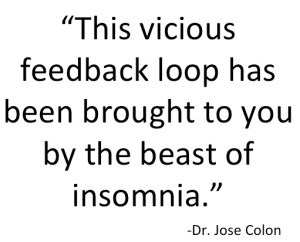Caveman Insomnia – Guest Post by Dr. Jose Colon
Insomnia is common. Sleep health advocates like those who follow Project Sleep and Paradise Sleep know insomnia is seen in people with sleep apnea, narcolepsy, and is flat out high in the general population as well. But why is insomnia so common? The answer can be be found in cave art.
Cave art? Yes, insomnia is common because we come from cavemen. Regardless of whether you believe in evolution or if you believe we came from a rib—and I love ribs by the way—nobody can deny there is art in the walls of caves. And therein lies the answer to the beast of insomnia.
The caveman that survived didn’t exactly know how to stop and smell the roses. Our ancestors had to out live the sabertooth tiger and the T-rex. One in ten cavemen ancestors died a barbaric death, and life expectancy was about 20 years. The cavemen that survived were agitated and anxious. Constantly thinking there was a tiger in the bush today would lead to senseless anxiety, but to the caveman this hypervigilant state led to survival. Constant agitation at others today may lead to road-rage (or cyber-rage), but to the caveman the short temper that led to barbaric violence would allow their offspring to live.
There was once cave art depicting a caveman that actually did stop and smell the roses, but on the next wall had are of a sabertooth tiger that chomped his head off. There was another cave art depicting a caveman meditating in a lotus position in an open field, but on the next wall there was art of a T-Rex chomping his head off. Okay… this is a mild dramatization. What exactly does cave art depict? Google it. Seriously! You’ll see spears, animals, and war. You’ll see a male hunter holding a spear with both hands over his head as if he was holding a Superbowl trophy.
But there are also hands depicted in cave art. Does this mean cavemen were willing to give each other a helping hand? Not so fast. First note that many of the hands are missing fingers or have shortened fingers. Signs of frostbite or injury. Also note that some have patterns. Single lines crossing an animal was said to represent a spear. Parallel lines were said to represent an animal’s mane, and rectangular grids were said to depict an animal trap. Barbaric and violent, the caveman that survived this world was anxious and agitated—and from that my friends comes the genetics of modern humanity.
What does agitation and anxiety have to do with insomnia? Everything! I like to explain the “hyperarousal” theory by comparing heart-rates to brain-rates. Just as you have a heart rate, we also have a brain rate. Our brain rate I like to describe as our level of alertness. If you are agitated, what does your heart do? It races. What does your mind do? It becomes more alert with racing thoughts. Same with anxiety. An anxious heart can race to a chest pain that may result in an ER visit. This is incompatible with sleep. Think dreams. Have you ever had a dream that you are walking and you miss a step? Everybody I know has woken up from this with a hypnic jerk and a pounding chest. To date I’ve never met anyone who has finished the dream, where they fall, crack their head, and then are waiting for hours in the ER sipping on burnt coffee.
If you’re in bed and your agitated that you’re not asleep, what does that do to your heart and mind? Bingo! Alertness. If you’re in bed and you’re anxious that you’re going to be tired the next day, what does that do to your heart and mind? Bingo! Alertness. This vicious feedback loop has been brought to you by the beast of insomnia.
How common is insomnia? Insomnia is experienced in about 40% of the industrialized population. Insomnia is seen in 50% of patients with narcolepsy (some argue insomnia in narcolepsy is more common than cataplexy). And in the general population 90% of people have had a bout of insomnia during life-stress events, the other 10% are in denial. Denial? Like the pot belly guy at the gym that walks by a mirror, sucks in his belly, and gives himself a thumbs up.
I’ve depicted quite a negative picture of the caveman in explaining the roots of insomnia and hyperarousal. But there are two sides to every story. The flipside of the caveman is that over the years the mind has evolved into a social organ. The caveman was wired to survive, and in that wiring was the development of love and nurturing that formed villages. Campfires, lullabies, and stories evolved. Humanity evolved to where it took a village to raise and nurture a child. And that is also where we now face a fork in the road in modern society were villages no longer stay together due to planes, trains, and automobiles. But fear not my friends. There are ways to build happiness, beat the stress of modern society, and reunite with peaceful sleep. I hope to see you this October in Denver at the Narcolepsy Network conference where I’ll be talking about Beating Stress by Building Happiness.
Encourage others to encourage others.
About the author: Jose Colon, M.D., MPH, specializes in sleep disorders and is the author of The Sleep Diet, A Novel Approach to Insomnia and the children’s sleep book, The Magic Ice Cream Palace. Dr. Jose Colon is the founder of Paradise Sleep, an organization dedicated to education in sleep health. Dr. Colon is dual board-certified in sleep medicine and neurology with special qualifications in child neurology.







